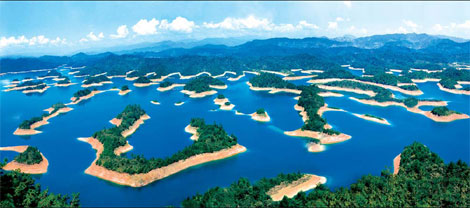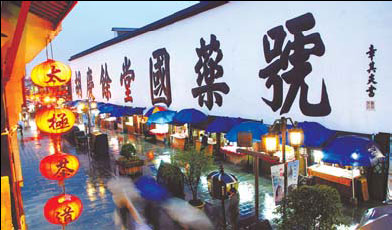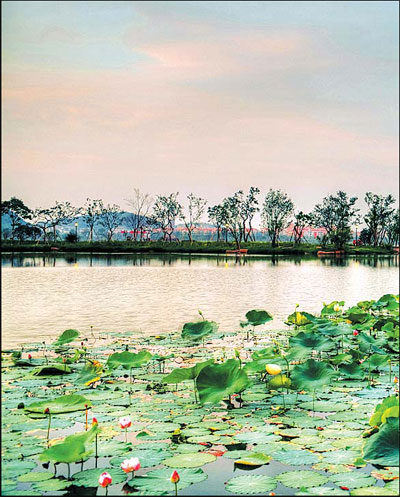Ancient Hangzhou adds color to World Expo journey

|
Picturesque scenery of the Qiandao Lake. Photos provided to China Daily |
|
The Huqingyutang medicine house, complete with an elegant courtyard, was founded by businessman Hu Xueyan in the late Qing Dynasty (1624-1911). |
As visitors flock to Shanghai in May for the 2010 World Expo, the nearby ancient city of Hangzhou is offering its range of scenery, history and amenities as attractions along their journey.
Less than two hours by car from Shanghai, the former capital of the Song Dynasty (1127-1279) even hosted a foreign visitor as far back as the 13th century - Marco Polo, who remembered Hangzhou as "the most exquisite heaven-like city in the world".
The city's beauty has also been the subject of renowned Chinese poems. One of the most well known is by Su Shi, who wrote: "Up above there is heaven, down below there are Suzhou and Hangzhou", also implying that the city is heaven on earth.
Today Hangzhou is an award-winning city for its quality of life, historic sites, economic development and comfortable surroundings.
Guests can walk around West Lake, taste local foods and relax in teahouses. But what makes it an attractive place for many is the slow pace of life.
Hangzhou has topped the list of the 10 happiest cities in China for six years, as ranked by the magazine Oriental Outlook affiliated with Xinhua News Agency.
In February 2007, Hangzhou was honored as the Best Tourism City in China by National Tourism Administration and World Tourism Organization.
Top scenic areas
West Lake at the city's center "may be compared to a fine lady, whether she is richly adorned or plainly dressed", according to the poet Su.
The lakefront has undergone major renovation since 2002, with many of the scenic sites mentioned in poems now available to visitors.
A Buddhist monastery along the lake built in 326 AD houses the tallest wooden Buddha in China, standing 25 meters high and covered in gold foil
Legend has it that nearby Leifeng Tower was built to lock up a white snake that fell in love with the intellectual Xu Xian. It now houses a collection of historic relics.
Nature lovers can visit Xixi National Wetland Park, the first in China.

Visitors can also explore streets bordering the 1,400-year-old Beijing-Hangzhou Grand Canal or a ride in a boat along its waters.
Xiaohezhi Street that follows a river and the canal is now a neighborhood that combines residences, leisure sites and businesses.
Zhongshan Road, a former royal passageway for Song Dynasty emperors, offers a glimpse of the color, culture and lifestyle of local residents.
Nearby Song City, the biggest visitor park in China, offers traditional Song-style buildings and markets built according to historical records.
An archaeological site 20 km from the town center first unearthed in 1936 offers a museum to showcase 400 ancient relics.
Hangzhou also has a long history of traditional Chinese medicine. The Huqingyutang medicine house, complete with an elegant courtyard, was founded by businessman Hu Xueyan in the late Qing Dynasty (1624-1911).
To meet more recent demand, services like massage and foot bathing are offered.
The city's renowned silk is available in fabrics, scarves, ties and other products that are also sold across the country and in international markets.
Xi Ling at Gu Mountain offers fine examples of southern China's gardens and sculpture, with the works of many well-known artists from the Tang Dynasty to modern times on display.
The Zhu'ertan Community near the fish market bridge over the Grand Canal opens its homes to visitors, where they can share with residents the aspects that comprise Hangzhou's way of life.
Many residents and tourists gather at the Qiantang River to watch high tide during the eighth month of the lunar year, which rolls in as high as a wall. A special tide-watching pavilion has been built to enjoy the natural wonder.
Visitors can also travel to Tianmu Mountain, the Fuchun River, the Xin'an River or Qiandao Lake, all scenic hotspots.
There are also old towns on Fuyang Mountain that offer a view of the culture and life in the time of Sun Quan, one of the emperors in the Three Kingdoms period.
Another destination is Qiandao Lake, which has 1,078 islands.
|
A glance of the Xianghu Lake in Xiaoshan. |
(China Daily 05/01/2010 page23)

















